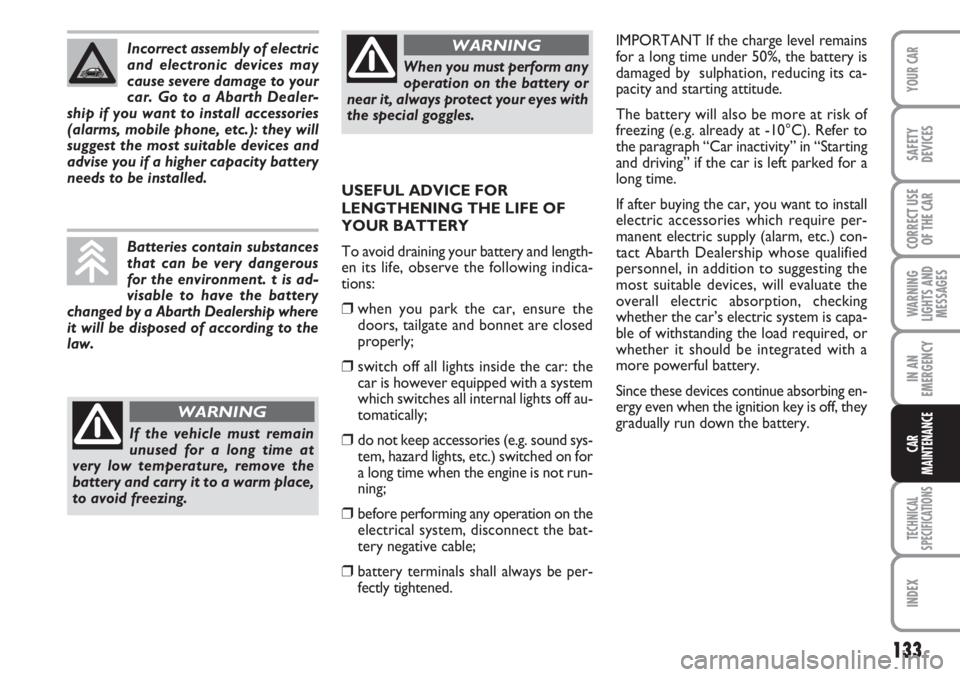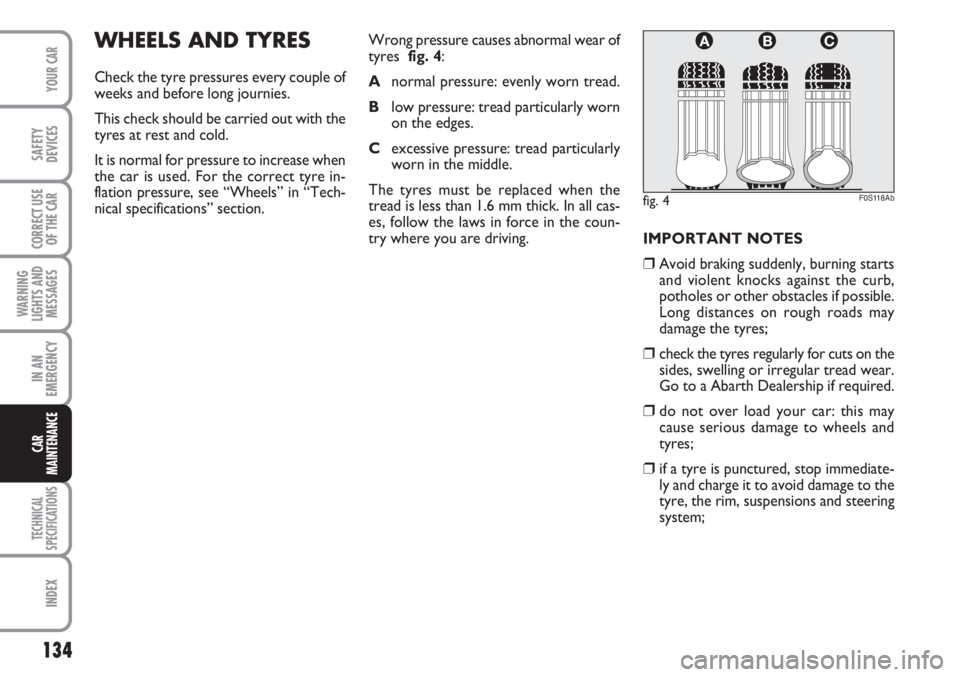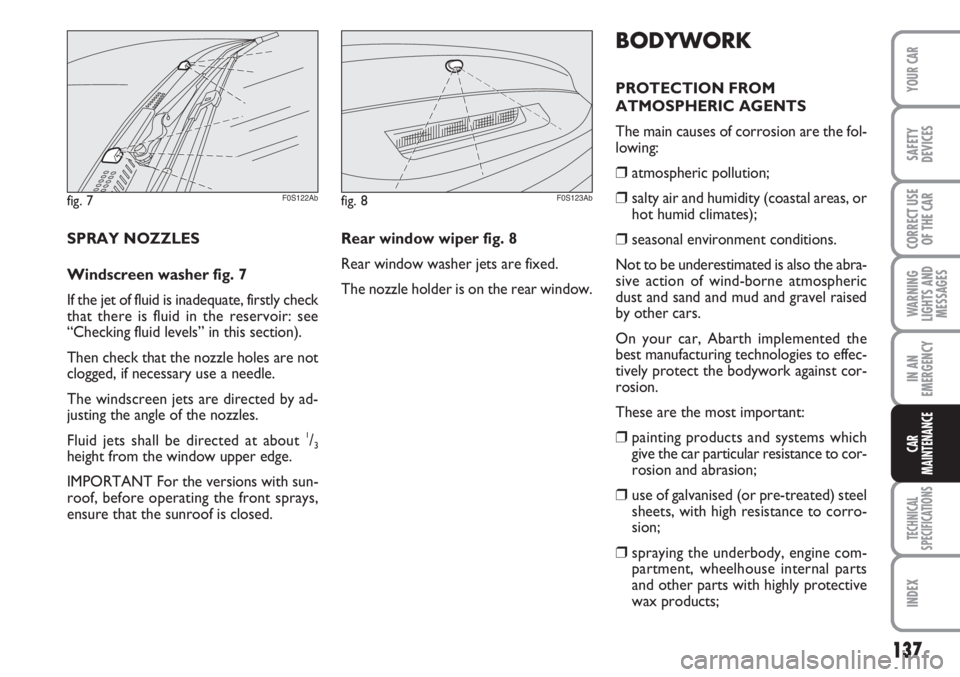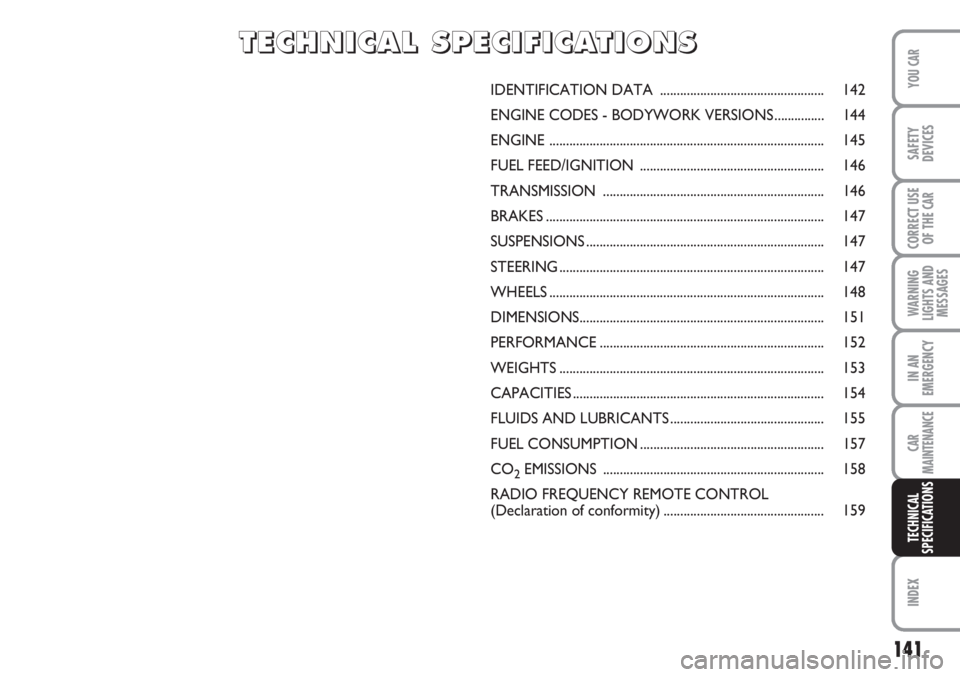technical specifications Abarth 500 2011 Owner handbook (in English)
[x] Cancel search | Manufacturer: ABARTH, Model Year: 2011, Model line: 500, Model: Abarth 500 2011Pages: 170, PDF Size: 3.5 MB
Page 133 of 170

132
WARNING
LIGHTS AND
MESSAGES
TECHNICAL
SPECIFICATIONS
INDEX
YOUR CAR
SAFETY
DEVICES
CORRECT USE
OF THE CAR
IN AN
EMERGENCY
CAR
MAINTENANCE
AIR CLEANER/
POLLEN FILTER
Have the air cleaner or the pollen filter re-
placed by a Abarth Dealership.
BATTERY
The car fits a low-maintenance battery: no
top-ups with distilled water are needed in
normal conditions of use.
INSPECTING THE CHARGE
AND THE ELECTROLYTE LEVEL
Inspection operations must be carried out
by specialised personnel, following the
prescriptions contained in the Use and
maintenance booklet. Any top-up opera-
tions must be carried out by specialised
personnel and by Abarth Dealership.
Battery liquid is poisonous
and corrosive. Avoid contact
with the skin and eyes. Keep naked
flames and sources of sparks away
from the battery: risk of explosion
and fire.
WARNING
Running the battery with an
excessively low liquid level
will damage the battery beyond re-
pair and even cause an explosion.
WARNING
CHANGING THE BATTERY
If required, replace the battery with a gen-
uine spare part having the same specifi-
cations.
If a battery with different specifications is
fitted, the service intervals given in the
“Service schedule” in this section will no
longer be valid.
Refer therefore to the instructions pro-
vided by the battery manufacturer.
Page 134 of 170

133
WARNING
LIGHTS AND
MESSAGES
TECHNICAL
SPECIFICATIONS
INDEX
YOUR CAR
SAFETY
DEVICES
CORRECT USE
OF THE CAR
IN AN
EMERGENCY
CAR
MAINTENANCE
IMPORTANT If the charge level remains
for a long time under 50%, the battery is
damaged by sulphation, reducing its ca-
pacity and starting attitude.
The battery will also be more at risk of
freezing (e.g. already at -10°C). Refer to
the paragraph “Car inactivity” in “Starting
and driving” if the car is left parked for a
long time.
If after buying the car, you want to install
electric accessories which require per-
manent electric supply (alarm, etc.) con-
tact Abarth Dealership whose qualified
personnel, in addition to suggesting the
most suitable devices, will evaluate the
overall electric absorption, checking
whether the car’s electric system is capa-
ble of withstanding the load required, or
whether it should be integrated with a
more powerful battery.
Since these devices continue absorbing en-
ergy even when the ignition key is off, they
gradually run down the battery. USEFUL ADVICE FOR
LENGTHENING THE LIFE OF
YOUR BATTERY
To avoid draining your battery and length-
en its life, observe the following indica-
tions:
❒when you park the car, ensure the
doors, tailgate and bonnet are closed
properly;
❒switch off all lights inside the car: the
car is however equipped with a system
which switches all internal lights off au-
tomatically;
❒do not keep accessories (e.g. sound sys-
tem, hazard lights, etc.) switched on for
a long time when the engine is not run-
ning;
❒before performing any operation on the
electrical system, disconnect the bat-
tery negative cable;
❒battery terminals shall always be per-
fectly tightened. Incorrect assembly of electric
and electronic devices may
cause severe damage to your
car. Go to a Abarth Dealer-
ship if you want to install accessories
(alarms, mobile phone, etc.): they will
suggest the most suitable devices and
advise you if a higher capacity battery
needs to be installed.
Batteries contain substances
that can be very dangerous
for the environment. t is ad-
visable to have the battery
changed by a Abarth Dealership where
it will be disposed of according to the
law.
If the vehicle must remain
unused for a long time at
very low temperature, remove the
battery and carry it to a warm place,
to avoid freezing.
WARNING
When you must perform any
operation on the battery or
near it, always protect your eyes with
the special goggles.
WARNING
Page 135 of 170

134
WARNING
LIGHTS AND
MESSAGES
TECHNICAL
SPECIFICATIONS
INDEX
YOUR CAR
SAFETY
DEVICES
CORRECT USE
OF THE CAR
IN AN
EMERGENCY
CAR
MAINTENANCE
WHEELS AND TYRES
Check the tyre pressures every couple of
weeks and before long journies.
This check should be carried out with the
tyres at rest and cold.
It is normal for pressure to increase when
the car is used. For the correct tyre in-
flation pressure, see “Wheels” in “Tech-
nical specifications” section.
fig. 4F0S118Ab
IMPORTANT NOTES
❒Avoid braking suddenly, burning starts
and violent knocks against the curb,
potholes or other obstacles if possible.
Long distances on rough roads may
damage the tyres;
❒check the tyres regularly for cuts on the
sides, swelling or irregular tread wear.
Go to a Abarth Dealership if required.
❒do not over load your car: this may
cause serious damage to wheels and
tyres;
❒if a tyre is punctured, stop immediate-
ly and charge it to avoid damage to the
tyre, the rim, suspensions and steering
system; Wrong pressure causes abnormal wear of
tyres fig. 4:
Anormal pressure: evenly worn tread.
Blow pressure: tread particularly worn
on the edges.
Cexcessive pressure: tread particularly
worn in the middle.
The tyres must be replaced when the
tread is less than 1.6 mm thick. In all cas-
es, follow the laws in force in the coun-
try where you are driving.
Page 136 of 170

135
WARNING
LIGHTS AND
MESSAGES
TECHNICAL
SPECIFICATIONS
INDEX
YOUR CAR
SAFETY
DEVICES
CORRECT USE
OF THE CAR
IN AN
EMERGENCY
CAR
MAINTENANCE
RUBBER HOSES
As far as the brake system and fuel rubber
hoses are concerned, carefully follow the
“Service schedule” in this section.
Ozone, high temperatures and prolonged
lack of fluid in the system may cause hard-
ening and cracking of the hoses, with pos-
sible leaks. Careful inspections are there-
fore necessary.
❒a tyre will age even if it is not used
much. Cracks in the tread and on the
sidewalls are a sign of ageing. Have the
tyres checked by specialised personnel
if they have been fitted for longer than
6 years;
❒In the case of replacement, always fit
new tyres, avoiding those of dubious
origin;
❒If a tyre is changed, also change the in-
flation valve;
❒to allow even wear between the front
and rear tyres, it is advisable to change
them over every 10-15 thousand kilo-
metres, keeping them on the same side
of the car so as not to reverse the di-
rection of rotation.
Remember that the road
holding qualities of your car
also depends on the correct inflation
pressure of the tyres.
WARNING
If the pressure is too low the
tyre will get overheated, with
the risk of serious damages.
WARNING
Avoid moving the tyres from
the right side of the vehicle
to the left side and vice versa.
WARNING
Do not repaint alloy wheel
rims at temperatures higher
than 150°C. The mechanical charac-
teristics of the wheels might be dis-
rupted.
WARNING
Page 137 of 170

136
WARNING
LIGHTS AND
MESSAGES
TECHNICAL
SPECIFICATIONS
INDEX
YOUR CAR
SAFETY
DEVICES
CORRECT USE
OF THE CAR
IN AN
EMERGENCY
CAR
MAINTENANCE
WINDSCREEN/
REAR WINDOW
WIPERS
BLADES
Periodically clean the rubber part using
special products; TUTELA PROFES-
SIONAL SC 35 is recommended.
Replace the blades if the rubber edge is de-
formed or worn. In all cases, it is advisable
to replace them approximately once a year.
A few simple precautions can reduce the
possibility of damage to the blades:
❒make sure that the rubber part is not
stuck to the windscreen at sub-zero
temperatures. Use an antifreeze prod-
uct to release it if required.
❒remove the snow from the window:
this will avoid overstressing the elec-
trical motor in addition to protecting
the blades;
❒do not operate the windscreen and the
rear screen wipers on dry glass.Replacing the windscreen
wiper blades fig. 5
Proceed as follows:
❒lift the arm Aof the wiper and position
the blade so that it forms an angle of
90° with the arm itself;
❒press the button Aand extract from
the arm Bthe brush C;
❒insert the new blade making sure it is
locked.
fig. 5F0S119Ab
Driving with worn wiper
blades is a serious hazard,
because visibility is reduced in bad
weather.
WARNING
Changing the rear
window blade fig. 6
Proceed as follows:
❒raise the cover Aand remove the arm
from the car, slackening the nut Bthat
fastens it to the pivot pin;
❒fit the new arm, positioning it correct-
ly, and fully tighten the nut;
❒lower the cover.
fig. 6F0S120Ab
Page 138 of 170

137
WARNING
LIGHTS AND
MESSAGES
TECHNICAL
SPECIFICATIONS
INDEX
YOUR CAR
SAFETY
DEVICES
CORRECT USE
OF THE CAR
IN AN
EMERGENCY
CAR
MAINTENANCE
BODYWORK
PROTECTION FROM
ATMOSPHERIC AGENTS
The main causes of corrosion are the fol-
lowing:
❒atmospheric pollution;
❒salty air and humidity (coastal areas, or
hot humid climates);
❒seasonal environment conditions.
Not to be underestimated is also the abra-
sive action of wind-borne atmospheric
dust and sand and mud and gravel raised
by other cars.
On your car, Abarth implemented the
best manufacturing technologies to effec-
tively protect the bodywork against cor-
rosion.
These are the most important:
❒painting products and systems which
give the car particular resistance to cor-
rosion and abrasion;
❒use of galvanised (or pre-treated) steel
sheets, with high resistance to corro-
sion;
❒spraying the underbody, engine com-
partment, wheelhouse internal parts
and other parts with highly protective
wax products; SPRAY NOZZLES
Windscreen washer fig. 7
If the jet of fluid is inadequate, firstly check
that there is fluid in the reservoir: see
“Checking fluid levels” in this section).
Then check that the nozzle holes are not
clogged, if necessary use a needle.
The windscreen jets are directed by ad-
justing the angle of the nozzles.
Fluid jets shall be directed at about
1/3height from the window upper edge.
IMPORTANT For the versions with sun-
roof, before operating the front sprays,
ensure that the sunroof is closed.Rear window wiper fig. 8
Rear window washer jets are fixed.
The nozzle holder is on the rear window.
fig. 7F0S122Abfig. 8F0S123Ab
Page 139 of 170

138
WARNING
LIGHTS AND
MESSAGES
TECHNICAL
SPECIFICATIONS
INDEX
YOUR CAR
SAFETY
DEVICES
CORRECT USE
OF THE CAR
IN AN
EMERGENCY
CAR
MAINTENANCE
❒spraying of plastic parts, with a protec-
tive function, in the more exposed
points: underdoor, inner fender parts,
edges, etc.
❒use of “open” boxed sections to pre-
vent condensation and pockets of mois-
ture from triggering rust inside.
BODY AND UNDERBODY
WARRANTY
Your car is covered by warranty against
perforation due to rust of any original el-
ement of the structure or body.
For the general terms of this warranty, re-
fer to Warranty Booklet.
ADVICE FOR PRESERVING
THE BODYWORK
Paint
Paintwork does not only serve an aes-
thetic purpose, but also protects the un-
derlying sheet metal.
Touch up abrasions and scratches immedi-
ately to prevent the formation of rust. On-
ly use genuine spare paint products for
touch-ups (see “Bodywork paint identifi-
cation plate” in the “Technical Specifica-
tions” section).Normal maintenance of paintwork consists
in washing the car: the frequency depends
on the conditions and environment where
the car is used. For example, it is advisable
to wash the car more often in areas with
a high environmental pollution or on roads
sprinkled with salt.
To correctly wash the car:
❒remove the aerial from the roof to pre-
vent damage to it if the car is washed in
an automatic system;
❒if high pressure water jets are used to
wash the car, make sure they are at
least 40 cm away from the bodywork
to avoid causing damage. It should be
remembered that a build up of water
could cause damage, in the long term,
to the car;
❒wash the body using a low pressure jet
of water;
❒wipe a sponge with a slightly soapy so-
lution over the bodywork, frequently
rinsing with the sponge;
❒rinse well with water and dry with a jet
of air or a chamois leather.
Dry the parts less in sight particularly care-
fully, such as the door frames and the
headlight frames, where water may stag-
nate more easily. It is a good idea to leave
the car in the open for a while after wash-
ing it to give time for the water to evap-
orate.Do not wash the car after it has been
parked in the sun or when the engine is
bonnet is hot: this could take the shine off
the paint.
Exterior plastic parts must be cleaned in
the same way as the rest of the car.
Where possible, do not park under trees;
the resinous substance many species re-
lease give the paint a dull appearance and
increase the possibility of triggering rust
processes.
IMPORTANT Bird droppings must be
washed off immediately and thoroughly as
the acid they contain is particularly ag-
gressive.
Detergents cause water pollu-
tion. The car should be washed
in areas equipped for collect-
ing and purifying the liquid
used in the washing process.
Page 140 of 170

139
WARNING
LIGHTS AND
MESSAGES
TECHNICAL
SPECIFICATIONS
INDEX
YOUR CAR
SAFETY
DEVICES
CORRECT USE
OF THE CAR
IN AN
EMERGENCY
CAR
MAINTENANCE
INTERIORS
Periodically check that water is not trapped
under the mats (due to water dripping off
shoes, umbrellas, etc.) which could cause
oxidisation of the sheet metal. Front headlights
IMPORTANT Never use aromatic sub-
stances (e.g.: petrol) or ketenes (e.g.: ace-
tone) for cleaning front headlight plastic
lens. Windows
Use specific window cleaner products.
Use also clean cloths to avoid scratching
the glass or damaging the transparency.
IMPORTANT The inside of the rear win-
dow should be wiped gently with a cloth
in the direction of the filaments to avoid
damaging the heating device.
Engine compartment
At the end of each winter, thoroughly
wash the engine compartment, taking care
to avoid directly hitting with the water jet
the electronic control units and the re-
lay/fuse control unit on the left side of the
engine compartment (running direction).
Have this operation performed at a spe-
cialised workshop.
IMPORTANT Perform this operation on
a cold engine and with the key at STOP.
After the washing operation, make sure
that the various protections (e.g. rubber
caps and guards) have not been removed
or damaged.
Never use flammable prod-
ucts, such as petrol ether or
rectified petrol to clean inside the car.
The electrostatic charges which are
generated by rubbing during the
cleaning operation may cause a fire.
WARNING
Don’t keep aerosol cans in
the vehicle: risk of explosion.
Aerosol cans must not be exposed to
a temperature exceeding 50°C. When
the vehicle is exposed to sunlight, in-
ner temperature can greatly exceed
this value.
WARNING
Page 141 of 170

140
WARNING
LIGHTS AND
MESSAGES
TECHNICAL
SPECIFICATIONS
INDEX
YOUR CAR
SAFETY
DEVICES
CORRECT USE
OF THE CAR
IN AN
EMERGENCY
CAR
MAINTENANCE
CLEANING SEATS
AND FABRIC PARTS
Remove dust with a soft brush or a vacu-
um cleaner. It is advisable to use a moist
brush on velvet upholstery.
Rub the seats with a sponge moistened
with a solution of water and neutral de-
tergent.INTERIOR PLASTIC PARTS
It is advisable to clean interior parts with
a moist cloth and a solution of water and
mild soap. Use specific products for clean-
ing plastic, without solvents and specifically
designed to prevent damage to the ap-
pearance and colour of the treated parts
to remove grease and tough stains.
IMPORTANT Never use spirit or petro-
leum to clean the instrument panel.
Page 142 of 170

141
WARNING
LIGHTS AND
MESSAGES
INDEX
YOU CAR
SAFETY
DEVICES
CORRECT USE
OF THE
CAR
IN AN
EMERGENCY
CAR
MAINTENANCE
TECHNICAL
SPECIFICATIONS
IDENTIFICATION DATA ................................................. 142
ENGINE CODES - BODYWORK VERSIONS ............... 144
ENGINE .................................................................................. 145
FUEL FEED/IGNITION ....................................................... 146
TRANSMISSION .................................................................. 146
BRAKES................................................................................... 147
SUSPENSIONS....................................................................... 147
STEERING ............................................................................... 147
WHEELS.................................................................................. 148
DIMENSIONS......................................................................... 151
PERFORMANCE ................................................................... 152
WEIGHTS............................................................................... 153
CAPACITIES ........................................................................... 154
FLUIDS AND LUBRICANTS .............................................. 155
FUEL CONSUMPTION....................................................... 157
CO
2EMISSIONS .................................................................. 158
RADIO FREQUENCY REMOTE CONTROL
(Declaration of conformity) ................................................ 159
T T
E E
C C
H H
N N
I I
C C
A A
L L
S S
P P
E E
C C
I I
F F
I I
C C
A A
T T
I I
O O
N N
S S